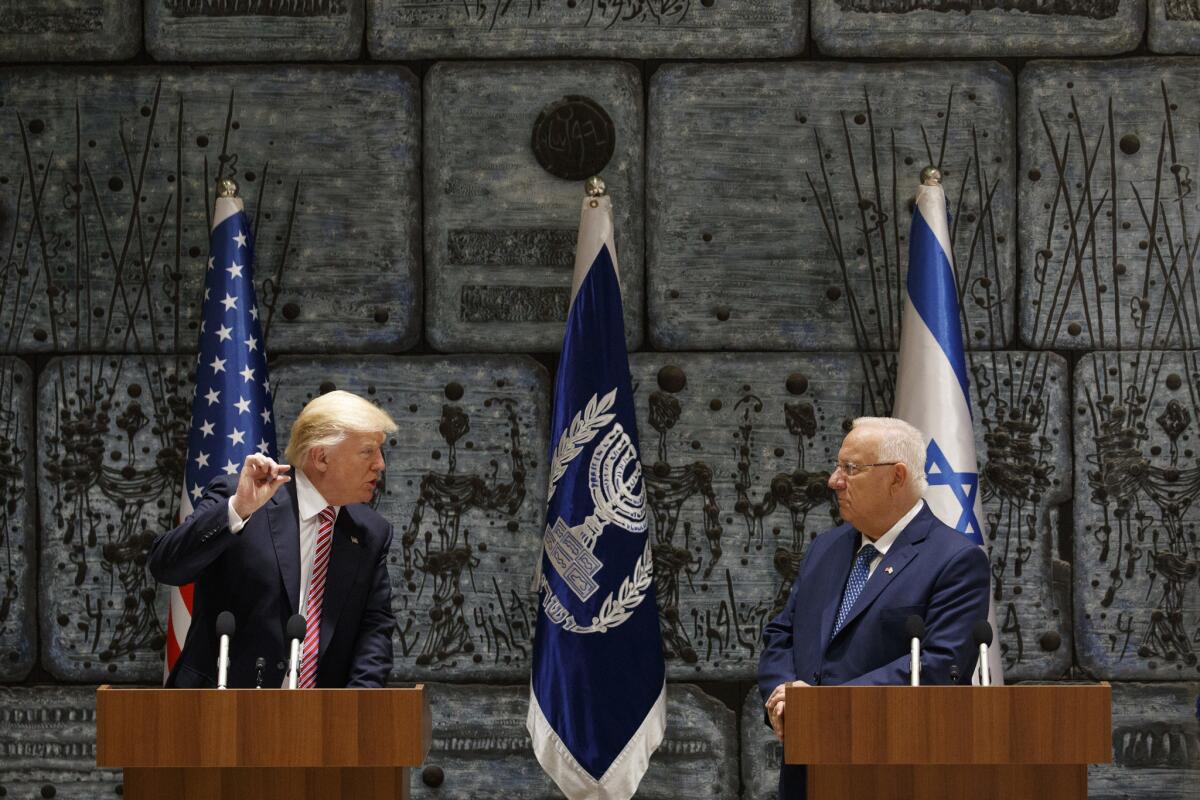Trump urges Israelis and Palestinians to work together for peace

- Share via
Reporting from Jerusalem — President Trump on Monday took in the sweeping history of Jerusalem’s Old City on a visit in which he hopes to make some of his own, urging Israeli and Palestinian leaders to take strides toward peace that have eluded U.S. leaders for decades.
Starting the second leg of his eight-day foreign trip, Trump said he wants to make progress on what he has called the “ultimate deal,” a Middle East peace accord to end generations of conflict.
“We have before us a rare opportunity to bring security and stability and peace to this region and to its people,” Trump said in a ceremony after he landed at Tel Aviv’s Ben Gurion Airport. “But we can only get there working together. There is no other way.”
Trump has yet to offer a diplomatic initiative to restart negotiations, no less break the broader political impasse. Nor is it clear whether the Israelis or the Palestinians have the inclination or political capital to make substantial progress given their deep divisions.
Still, Trump raised the prospect of a peace deal during each of his three public appearances with Israeli Prime Minister Benjamin Netanyahu on Monday, though in the third he conceded it was perhaps the “toughest” deal to make.
Netanyahu leads a fragile coalition that depends on right-leaning parties who strongly resist the kinds of territorial or political concessions to Palestinians that a peace deal likely would require.
So he sought continually to steer the conversation toward Iran, a common foe for Israel and the Sunni Arab leaders whom Trump visited over the weekend in Saudi Arabia.
Trump’s call in a speech Sunday in Riyadh, Saudi Arabia, to isolate Iran to neutralize the threat it poses through proxy militant groups “not only helps security but also helps propel the possibility of reconciliation and peace between Israel and the Arab world,” Netanyahu said.
But he said Israel has not changed its own formulation for peace, one that Saudi Arabia and most other Arab states have rejected until now.
“The peace we seek is a genuine and a durable one in which the Jewish state is recognized, security remains in Israel’s hands and the conflict ends once and for all,” the Israeli leader said.
Trump will travel Tuesday to Bethlehem, in the West Bank, to meet with Palestinian Authority President Mahmoud Abbas, who visited the White House this month.
In his comments Monday, Trump said he had “found new reasons for hope” in his meetings with Arab leaders in Riyadh.
Echoing a White House argument, Secretary of State Rex Tillerson said the common threat of terrorism has united Sunni Arab nations, Israel and the United States in a way that did not exist in the past.
“I think [Trump] feels like there’s a moment in time here,” Tillerson told reporters traveling with the president on Air Force One.
“I think the president has indicated he’s willing to put his own personal efforts into this, if the Israelis and the Palestinian leadership are ready to be serious about engaging as well,” he said.
Trump’s domestic troubles over Russia reemerged during his visit Monday, one with potential diplomatic consequences with Israel. As with many of the president’s problems, it was self-inflicted.
After a reporter asked Netanyahu if he was concerned by reports that Trump had shared highly sensitive intelligence about a terrorist threat with two senior Russian officials in an Oval Office meeting on May 10, Trump jumped in to deny that he ever “mentioned the word or the name Israel.”
“They’re all saying I did,” he said, pointing to reporters. “So you have another story wrong. Never mentioned the word Israel.”
News accounts never said that Trump had identified Israel as the source of the intelligence, only that he had divulged intelligence from an unnamed allied country that did not want it shared.
Subsequent news reports, citing anonymous sources, identified the country as Israel, and said Israeli intelligence officials were furious that Trump had shared the material in violation of spying protocol.
For his part, Netanyahu avoided the intelligence controversy. He cut through the shouts of multiple questioners to say simply, “Intelligence cooperation is terrific. It’s never been better.”
Trump heads to the Vatican after his two-day visit here, and the White House argues that his visit to holy sites of three of the world’s major religions demonstrates his commitment to religious tolerance and peace.
And so Trump is mixing religious symbolism with his substantive discussions.
Wearing a Jewish skullcap, he touched the stones of the Western Wall in Jerusalem and, as cameras clicked away, tucked a private note into one of the crannies. Nearby, First Lady Melania Trump and first daughter Ivanka visited the women’s area of the wall, one of Judaism’s most sacred sites.
He also visited the Church of the Holy Sepulcher, which Christians believe is the site where Jesus Christ was crucified and later resurrected.
“Words fail to capture the experience,” he said at day’s end. Fireworks later lighted the skies over Jerusalem.
Not only is Trump the first sitting U.S. president to visit the Western Wall, but he is also the first American president to visit Israel so early in his term. His arrival on Air Force One from Riyadh marks the first known direct flight between Saudi Arabia and Israel, which do not have formal diplomatic relations.
For the record:
8:46 a.m. Jan. 23, 2025An earlier version of this article incorrectly stated that Palestinian Authority President Mahmoud Abbas visited the White House last month. He visited this month.
For more White House coverage, follow @mikememoli on Twitter.
ALSO
Trump’s erratic style and thirst for a deal has some Israeli officials unnerved
Trump’s message to Arab leaders: Do more to fight extremism
A tale of two princes: A king’s son and a president’s son-in-law drive Trump’s visit
Get live updates on our Essential Washington news feed
More to Read
Get the L.A. Times Politics newsletter
Deeply reported insights into legislation, politics and policy from Sacramento, Washington and beyond. In your inbox three times per week.
You may occasionally receive promotional content from the Los Angeles Times.











